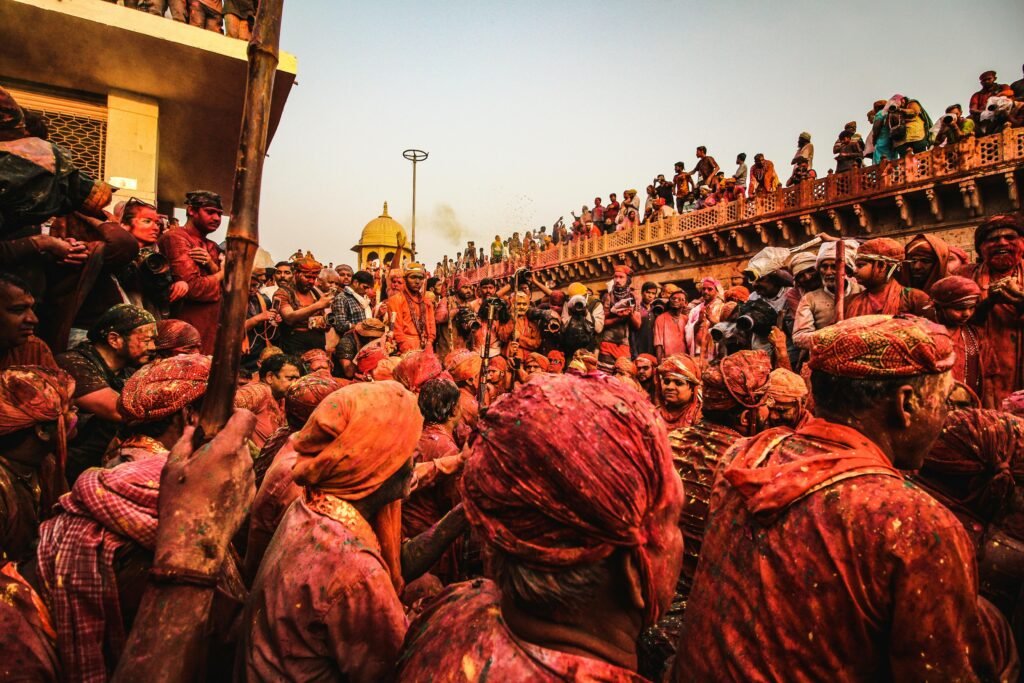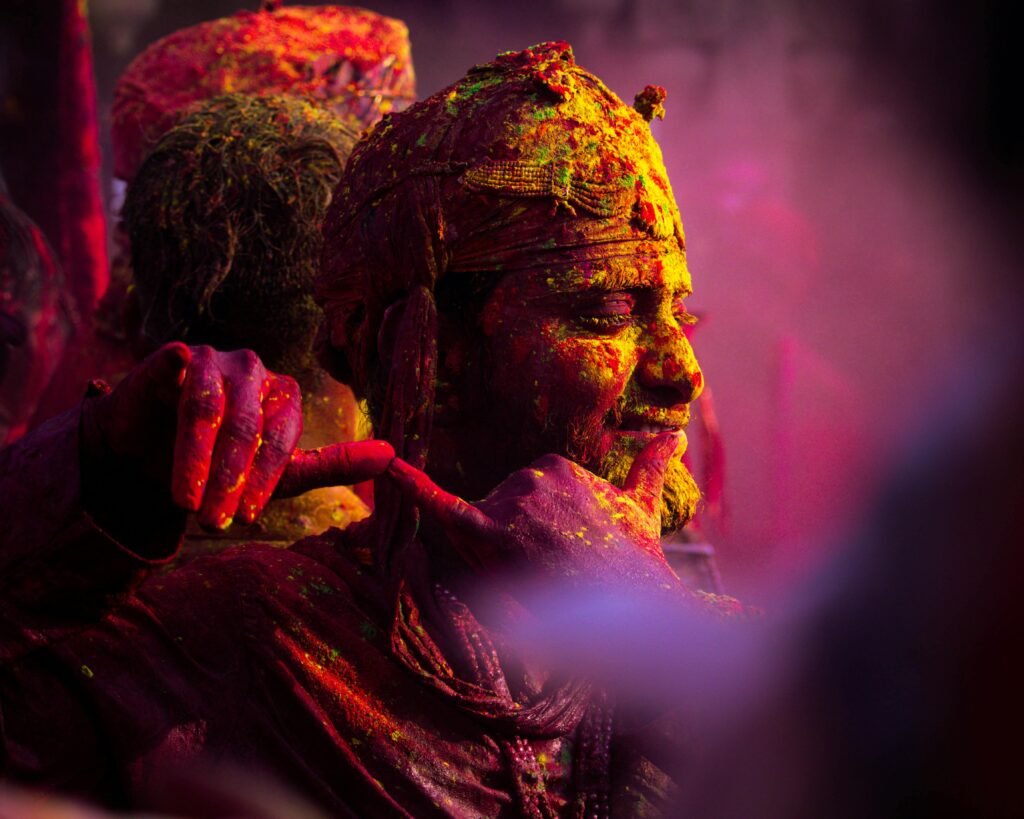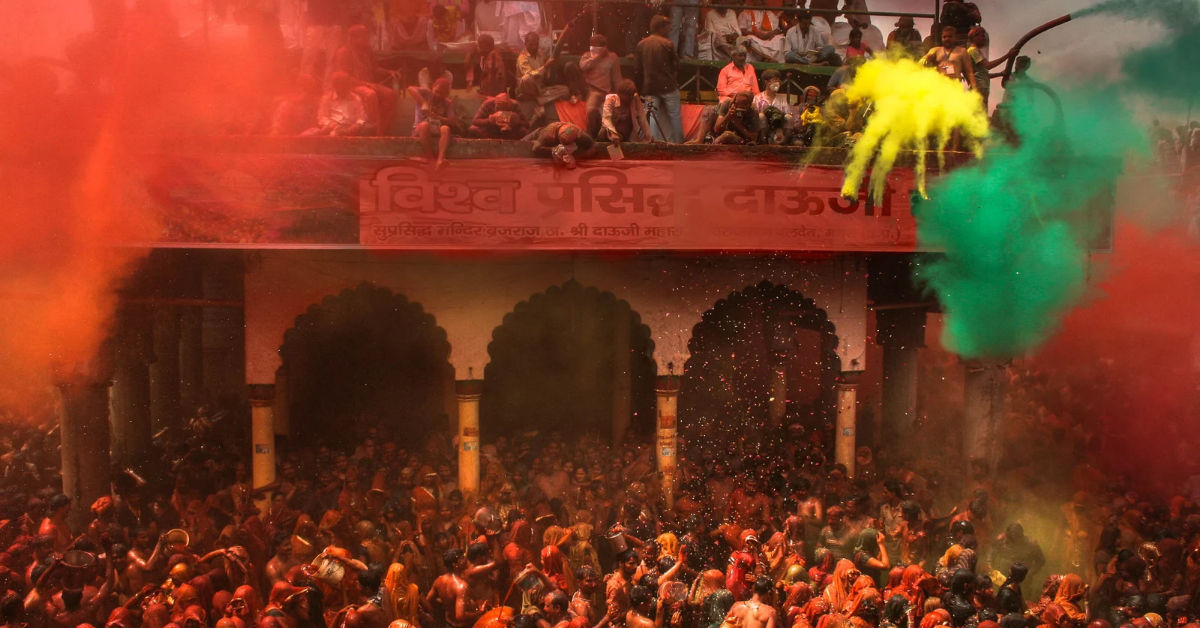
Introduction to Holi: The Festival of Colors
Holi is more than just a festival; it’s a symphony of colours, laughter, and togetherness that brings people closer. Celebrated across India and beyond, this ancient Hindu festival marks the arrival of spring and the victory of good over evil. The streets burst into a riot of colors, and the air fills with the sweet aroma of festive treats and joyous melodies. Whether you playfully drench others in gulal (colored powder) or indulge in a crispy, syrup-filled gujiya, Holi becomes more than just a festival—it turns into an emotion that stays with you forever. Across India, temple Holi traditions add a spiritual touch, blending devotion with vibrant revelry. In Vrindavan’s Banke Bihari Temple, priests shower devotees with flower petals during Phoolon ki Holi, while in Barsana, women joyfully chase and playfully strike men with sticks during Lathmar Holi, recreating Krishna and Radha’s divine love. Wherever you celebrate, Holi’s magic fills your heart with unforgettable joy and devotion.
A Festival Rooted in Mythology and Devotion
Like many Indian festivals, Holi has deep roots in Hindu mythology. Thus,making it a spiritual as well as a cultural celebration.
The most famous legend behind Holi is the tale of Prahlad and Holika. Prahlad, a young devotee of Lord Vishnu, was targeted by his tyrannical father, King Hiranyakashipu. He wanted to destroy his faith. His aunt, Holika, who was believed to be immune to fire, tried to trick him into sitting with her in flames. But divine intervention saved Prahlad, while Holika perished, symbolizing the triumph of devotion over arrogance. This is why Holika Dahan, the ritual bonfire, is an essential part of Holi traditions across India.
A Celebration That Unites India in Unique Ways
Holi may be a national festival, but every region in India celebrates it differently. In Braj and Barsana, Lathmar Holi re-enacts Radha and Krishna’s playful love story. Here women chase men with sticks in a spirited tradition. While in West Bengal, Dol Jatra sees devotees carrying idols of Krishna and Radha.It is celebrated singing devotional songs as they play with colors. In Punjab, Holi blends with the warrior tradition of Hola Mohalla. Here the Sikh community showcases martial arts and daring feats. These diverse customs highlight the beauty of Holi traditions across India, proving that while the colours may differ, the spirit of celebration remains the same.
So, this Holi, wherever you are, let the colours bring joy, devotion, and a fresh start into your life!
Holi Celebrations in North India: A Spectacle of Colors, Devotion, and Joy
When you think of Holi traditions across India, the grandest and most vibrant celebrations happen in North India, particularly in Mathura, Vrindavan, Barsana, and Nandgaon. These holy towns, are deeply connected to Lord Krishna’s life. They transform into a breathtaking festival of colors, music, and devotion, drawing visitors from all over the world. The blend of mythology and merriment makes Holi in this region an unforgettable experience.
Lathmar Holi: A Playful Battle of Love in Barsana and Nandgaon
In Barsana and Nandgaon, Holi begins days before the rest of India with the legendary Lathmar Holi. This unique tradition reenacts Radha and Krishna’s divine love story in the most playful way. As per legend, Krishna, known for his mischievous nature, would visit Radha’s village, teasing her and the other gopis. In response, the women of Barsana playfully chased him away with sticks (laths).
Today, this tradition continues as men from Nandgaon visit Barsana, only to be met with women wielding sticks in a joyful battle of love. The event is accompanied by folk songs, dhol beats, and laughter, making it a must-visit celebration that reflects the fun-loving nature of Krishna’s leelas.
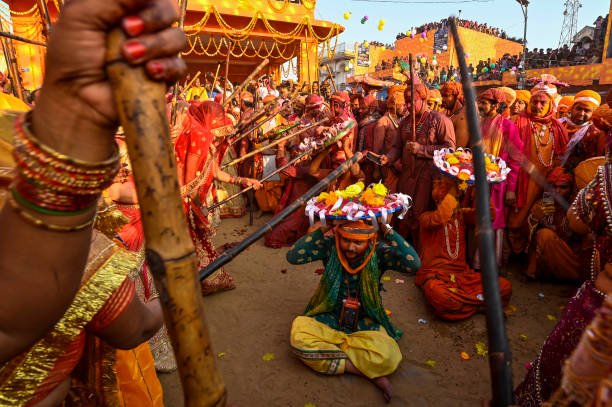
Mathura and Vrindavan: Where Devotion Meets Festivity
If there’s one place where Holi traditions across India reach their spiritual peak, it’s Mathura and Vrindavan. Mathura, Krishna’s birthplace, and Vrindavan, where he spent his childhood, turn into a sea of colours and devotion.
At Banke Bihari Temple in Vrindavan, priests shower devotees with fragrant flower petals, marking the joyous start of Phoolon ki Holi. In Dwarkadhish Temple, Mathura, grand processions fill the streets, with devotees singing bhajans and dancing to Krishna’s divine melodies. The celebrations culminate in colorful revelries where everyone—locals, tourists, saints, and devotees—become one in Krishna’s playful spirit.
Holi in North India is more than a festival—it’s a divine experience where mythology, devotion, and joy come alive in a riot of colours !
Holi in Western India: A Splash of Culture, Colors, and Celebration
When it comes to Holi traditions across India, Western India offers a vibrant mix of devotion, dance, and dazzling colors. The states of Maharashtra and Gujarat celebrate Holi in their own distinctive ways, blending ancient customs with modern festivities. Whether it’s Mumbai’s colorful streets or Gujarat’s energetic Garba dances, Holi here is a time of togetherness, joy, and spiritual significance.
Rangpanchami: Maharashtra’s Unique Holi Celebration
In Maharashtra, Holi is an extended festival, celebrated for days beyond the usual schedule. The most exciting part is Rangpanchami, observed five days after Holika Dahan. Maharashtrians extend Holi festivities by smearing colors and singing folk songs. They also indulge in sweet treats like puran poli and shrikhand.
Mumbai and Pune host grand Holi celebrations where communities gather to throw gulal and enjoy Lavani performances. People celebrate with joy, music, and festive enthusiasm. trace Maharashtra’s Holi enthusiasm to Chhatrapati Shivaji Maharaj, who encouraged celebrations to foster unity among his people. Even today, Holi serves as a symbol of togetherness, breaking social barriers through laughter and colours.
Dhuleti in Gujarat: A Riot of Colors and Rhythms
In Gujarat, Holi takes on a lively and musical form with Dhuleti. Here people drench each other in gulal and watercolours. The streets of Ahmedabad and Surat transform into a vibrant carnival during Holi. People dance to the rhythmic beats of Garba and Dandiya.
Whether you’re celebrating Rangpanchami in Maharashtra or dancing to Garba beats in Gujarat, Western India’s Holi is a colourful expression of unity, devotion, and festivity.
Holi in Eastern India: A Divine Celebration of Colours and Culture
Eastern India celebrates Holi with devotion, cultural elegance, and festivity. Bengal’s Dol Purnima is poetic and spiritual. Assam’s Phaguwa is energetic and colorful.
Dol Purnima: Bengal’s Spiritual and Artistic Holi
In West Bengal, Holi is celebrated as Dol Purnima, a festival that honours Lord Krishna and Radha’s eternal love. Devotees gracefully process through the streets, carrying beautifully adorned idols of Krishna and Radha on swings to symbolize their divine romance.
Dressed in saffron or white attire, devotees sing kirtans (devotional songs) and dance to the beats of traditional dhaak drums, creating a mesmerizing atmosphere. Inspired by Rabindranath Tagore, Shantiniketan’s Basanta Utsav (Spring Festival) adds a cultural touch, where students welcome Holi through music, poetry, and graceful dance performances. The festival truly blends art, devotion, and festivity into a magical experience.
Phaguwa in Assam: A Celebration of Fire and Colors
In Assam, Holi is known as Phaguwa, and it begins with a dramatic bamboo hut burning ceremony, representing the victory of good over evil—a reference to the legend of Holika and Prahlad. This grand ritual is followed by joyful color play, energetic Bihu dance performances, and the sharing of festive sweets like gujiya and laddoos.
Temples dedicated to Lord Krishna become the center of celebration, with devotees offering prayers and singing devotional songs. The beats of dhol and pepa fill the air, creating a joyful and festive atmosphere.
Bengal’s Dol Purnima is graceful, while Assam’s Phaguwa is vibrant and energetic. Holi in Eastern India blends tradition, devotion, and festive cheer.
Holi in South India: A Celebration of Fire, Flowers, and Faith
While Holi traditions across India are often associated with colorful celebrations in the north, the southern states bring their own unique and deeply spiritual touch to the festival. Instead of just throwing gulal, South India celebrates Holi with ritual bonfires and floral offerings. The festival reflects religious devotion and cultural heritage.
Kamadahana in Karnataka: The Fire That Burns Away Desires
In Karnataka, Holi is known as Kamadahana, a celebration that revolves around the burning of desires and ego. Lord Shiva opened his third eye and reduced Kamadeva, the God of Love, to ashes for disturbing his deep meditation. Later, Shiva revived Kamadeva in a spiritual form, celebrating devotion’s victory over worldly temptations.
To honour this story, huge bonfires are lit on the eve of Holi, representing the burning away of negativity and the start of a fresh, joyous season. Families gather around the fire, chanting prayers and singing devotional songs, reinforcing the belief that true happiness lies in inner peace, not material desires.
Kaman Pandigai in Tamil Nadu: A Floral Tribute to Love
Tamil Nadu’s Kaman Pandigai offers a softer, more fragrant version of Holi, where people use flowers instead of colors. Inspired by the Kamadeva legend, devotees create beautiful floral decorations and offer garlands to Lord Shiva, filling the air with the sweet scent of jasmine, marigolds, and roses.
Instead of throwing gulal, people shower each other with petals, sing devotional songs, and enjoy traditional sweets like payasam and adhirasam. This gentle, nature-friendly version of Holi reflects South India’s deep-rooted spiritual traditions.
A Celebration of Devotion and Renewal
Unlike the boisterous Holi revelry of the north, Holi in South India is a blend of devotion, mythology, and natural beauty. Whether through the sacred flames of Kamadahana or the fragrant charm of Kaman Pandigai, the festival brings people together in a celebration of love, faith, and renewal.
Holi in Central India: A Burst of Colours and Culture
In the heart of India, Madhya Pradesh takes Holi celebrations to a whole new level, blending ancient traditions with modern excitement. Whether you’re in the bustling streets of Indore or the historic lanes of Gwalior, Holi here is more than just a festival—it’s an experience you’ll never forget.
A Festival Rooted in Devotion and Mythology
Madhya Pradesh starts Holi with Holika Dahan, symbolizing the victory of good over evil. Prahlad’s devotion saved him, but Holika burned. In temples across the state, devotees chant hymns and offer prayers, seeking divine blessings before the grand celebrations begin.
Unique Holi Traditions Across Madhya Pradesh
Each city in Madhya Pradesh adds its own charm to Holi. In Bundelkhand, women playfully chase men with sticks in a tradition known as Lathmar Holi, just like in Barsana, Uttar Pradesh. Meanwhile, Gwalior celebrates Holi with soul-stirring Phag and Rasiya folk songs, echoing the love and mischief of Lord Krishna. Indore turns into a carnival of colors with grand processions, music, and dance performances that draw thousands of visitors.
A Tribal Touch to the Celebrations
The tribal communities of Mandla and Chhindwara add a rustic, mesmerizing flavor to Holi. Dressed in vibrant attire, they perform traditional dances and sing folk songs that narrate ancient legends. Their celebrations remind us of India’s deep cultural roots and the unity that festivals bring.
A Feast for the Senses
No Holi is complete without mouth-watering sweets! In Madhya Pradesh, you’ll find homes filled with the aroma of gujiyas, malpuas, and bhang thandai, making the festival as delicious as it is colorful.From devotional rituals to joyful revelry, Holi in Madhya Pradesh offers a perfect mix of tradition, spirituality, and festivity—just like every Holi tradition across India!
Unique Traditions and Rituals of Holi: A Festival of Colors, Fire, and Festive Joy
Holi is more than just a riot of colors—it’s a festival woven with age-old traditions, spiritual legends, and heartwarming customs. While the festival brings people together in joyous celebration, Holi traditions across India vary widely, with each region adding its own unique twist.
Holika Dahan: The Night of Bonfires and Legends
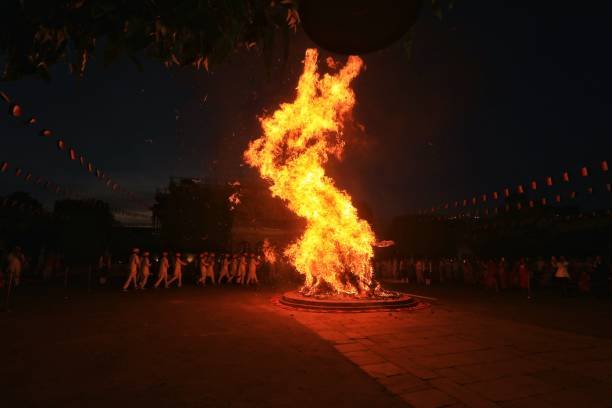
The excitement of Holi begins the night before with Holika Dahan, an ancient ritual symbolizing the victory of good over evil. The story of Prince Prahlad and his tyrannical father, King Hiranyakashipu, shapes this tradition in mythology. According to Hindu mythology, Prahlad’s unwavering devotion to Lord Vishnu angered his father, who sought to destroy him. The king’s sister, Holika, who was immune to fire, sat with Prahlad in a blazing pyre. But divine intervention reversed the outcome—Holika burned while Prahlad remained unharmed.
Today, communities gather around towering bonfires, offering coconuts, grains, and prayers as the flames rise. Devotees light the fire to ward off evil and bring prosperity, making it one of India’s most cherished Holi traditions. If you want to explore this ritual further, check out our guide on Holika Dahan.
Splashing Colours : A Playful Tribute to Lord Krishna
On the day of Holi, streets transform into a canvas of vibrant colours, a tradition that finds its roots in Lord Krishna’s playful pranks on Radha and the Gopis. It is said that young Krishna, unhappy with his dark complexion, playfully smeared colours on Radha’s face to match her fairness. This divine love story blossomed into the colour-splashing festival we see today.
With gulal (coloured powder) filling the air and water balloons bursting in every corner, Holi traditions across India turn towns and villages into a dazzling spectacle of joy.
Thandai, Gujiya, and Festive Delights
No Holi is complete without its iconic festive flavours . The cool, spiced drink Thandai, made with milk, almonds, saffron, and rose petals, keeps the festive spirit alive. Gujiya, a crispy dumpling filled with sweet khoya and nuts, melts in the mouth, leaving a lingering sweetness. Across India, people prepare special sweets and savouries, adding a delicious touch to the festival.
Holi is a festival of love, laughter, and letting go—a time when everyone, young and old, comes together in a joyful riot of colours and culture.
Cultural Significance and Modern Adaptations of Holi
Holi is not just about colours—it’s a festival of unity, renewal, and the triumph of good over evil. Deeply rooted in Hindu mythology, Holi traditions across India carry spiritual, social, and cultural significance, bringing people together in joyous celebration. It’s a time when barriers of age, status, and community fade away, replaced by laughter, music, and shared festivities.
A Celebration of Love, Forgiveness, and Togetherness
Holi’s essence lies in letting go of past grudges and embracing new beginnings. The festival symbolizes unconditional love, much like the divine bond between Radha and Krishna, whose playful Holi celebrations in Vrindavan and Mathura remain legendary. It is believed that Krishna, mischievous as ever, playfully smeared colours on Radha, giving birth to the tradition of throwing gulal (coloured powders). Every year, devotees re-enact this act of love, especially in Krishna temples across India.
Beyond mythology, Holi fosters brotherhood and harmony, dissolving social and economic divides. Traditionally, even kings and commoners would celebrate Holi together, sharing sweets and smearing colours on each other. The tradition continues today as neighborhoods, offices, and communities unite in a colourful spectacle.
The Global Rise of Holi
With India’s rich cultural influence worldwide, Holi has crossed borders and become an international phenomenon. Major cities in the U.S., U.K., Australia, and Canada host massive Holi celebrations. It features Bollywood music, dance performances, and colour-throwing festivals. These events attract thousands, proving that Holi’s message of love and joy is truly universal.
Sustainable and Modern Holi Traditions
As awareness of environmental conservation grows, many cities now encourage eco-friendly Holi traditions. The use of organic colors made from flowers, turmeric, and sandalwood has gained popularity, along with waterless Holi celebrations. These modern adaptations honour tradition while promoting sustainability, ensuring that Holi remains a festival of happiness, togetherness, and responsible celebration.
People across India celebrate Holi by filling life with color, laughter, and the joy of togetherness!
Conclusion: The Spirit of Holi Lives On
Holi is more than just a festival—it is a celebration of life, love, and togetherness. Across India, the festival brings people together, allowing them to forgive, reconnect, and rejoice in shared happiness. As the colors fill the air, so does the energy of unity, breaking barriers of caste, age, and social status. Life is meant to be celebrated with laughter, music, and the warmth of human connection.
Holi’s Modern-Day Transformation
Over time, Holi has embraced modern adaptations while keeping its essence intact. Today, there is a shift towards organic colours , water conservation, and eco-friendly celebrations. Thus, ensuring that the festival remains joyous yet sustainable. Beyond India, Holi has gained international recognition. With grand celebrations organised in New York, London and Singapore.Thus,proving that Holi traditions across India have a universal appeal.
The Colours of Unity and Joy
From Lathmar Holi in Uttar Pradesh to Phoolon ki Holi in Vrindavan, every region adds its own charm to the festival. Whether you celebrate with dry colors, flower petals, or traditional sweets like Gujiya and Thandai, Holi offers something special for everyone. It is a time to let go, laugh freely, and embrace the spirit of togetherness.
As we conclude our journey through Holi traditions across India, one thing is clear—Holi is not just a festival; it’s an experience that stays with you forever. Keep exploring India’s vibrant festivals with DivyaKripa, where every tradition tells a beautiful story of love, faith, and celebration!

